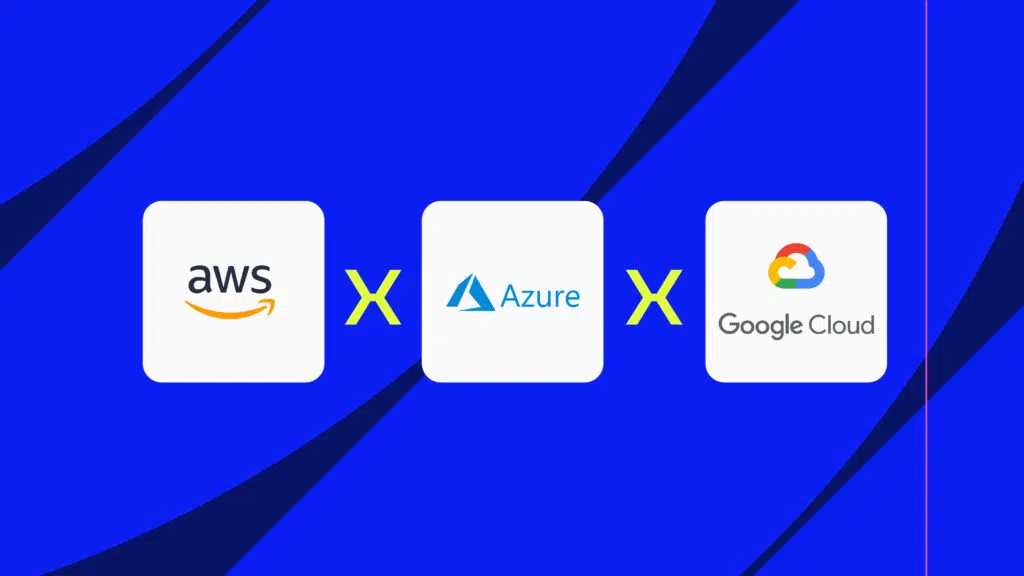Cloud migration is a strategic process by which organizations transfer their information systems , applications and data to cloud computing infrastructures .
This movement aligns with the search for more flexibility, scalability and operational efficiency, facilitating the management of IT resources and allowing a better response to market changes.
According to a Gartner study , approximately 85% of organizations will migrate to the cloud by 2025 .
Therefore, with the advancement of cloud technologies, companies of different sizes and sectors recognize the importance of adopting this approach to remain competitive.
Want to migrate to the cloud, but don't know where to start ? Stay calm! We have prepared a complete checklist to help you and your business on this important journey.
Check out!
Step 1 – Assessment of needs and objectives
Before beginning a migration to the cloud , companies should conduct a detailed assessment to understand their specific needs and define clear objectives. See below two important aspects in this regard:
Setting clear goals and objectives
It is essential that the company defines goals and objectives aligned with its business vision. The definition of objectives must be specific, measurable, achievable, relevant and time-bound (SMART) to ensure effectiveness in the migration process. For example:
- Specific: migrate 80% of retail operations to the cloud;
- Measurable: reduce system downtime by 25%;
- Achievable: improve the scalability of IT services;
- Relevant: align IT infrastructure with industry practices;
- With a defined time: complete the migration in 18 months.
Cost analysis and expected ROI
Financial contingency is crucial in migration planning. A detailed cost analysis comparing operating expense (OpEx) and capital expense (CapEx) models helps you make informed decisions.
The expected Return on Investment (ROI) must be projected to assess viability. An example of a cost comparison could be:
| Cloud Migration: How to Analyze Costs and Project ROI | ||
| Resource | Current costs | Post-migration costs |
| Infrastructure | R$100,000 | R$30,000 |
| Maintenance | R$15,000 | R$5,000 |
| Updates | R$10,000 | Included in the cloud |
| 24/7 Operation | R$50,000 | Included in the cloud |
The expected ROI must consider not only cost reduction, but also intangible benefits such as flexibility, scalability and innovation .
Step 2 – Choosing the right cloud migration platform
Selecting a cloud platform involves carefully analyzing the services offered and adapting them to business requirements. Therefore, it is crucial to understand the differences between the main providers to make an informed decision.
Comparison between different cloud service providers
Each provider offers a set of features that may suit your company's specific needs differently. An objective comparison must consider:
- Storage capacity: evaluate the volume of storable data;
- Computing power: check scalability options and processing performance;
- Global coverage: analyze the availability of data centers around the world;
- Pricing and cost models: Clearly understand how costs are calculated and whether there are pay-as-you-go options or subscription models.
Security Considerations, Scalability, and Features Offered
Information security is paramount when migrating to the cloud . You should investigate:
- Security certifications: identify whether the provider has certifications such as ISO 27001 , SOC 2 or other relevant certifications;
- Compliance policies: ensuring that the provider meets legal and regulatory requirements.
Scalability, in turn, is essential to support growth and variations in demand, without compromising performance. It is important that the platform offers:
- Automatic elasticity: to adjust resources according to needs;
- Variety of services: such as data analysis tools, artificial intelligence and machine learning.
When evaluating resources, one should check the range of innovative services available that can add value to the business, as well as the technical support offered.
Step 3 – Preparation of data and applications
Before migrating to the cloud , it is essential to evaluate and adapt data and applications for the process. This step ensures that the transition is efficient and safe.
Assessment and categorization of data to be migrated
A detailed analysis of the type and sensitivity of the data is carried out. Critical business data must be identified and categorized to ensure compliance and security . Consider creating a table like you can see below:
| Assessment and categorization of data to be migrated | |||
| Data type | Category | Sensitivity level | Compliance requirements |
| Financial | Critical | High | SOX, LGPD |
| HR | Sensitive | Average | GDPR |
| Operational logs | Not critical | Low | AT |
Adapting applications to the cloud environment
Applications require optimization before migrating to the cloud. Prioritize those that are best suited for the cloud environment, considering scalability and performance . Lists like this can help organize the process:
- Applications to be refactored:
- Customer management system – requires more resources to scale;
- Sales portal – needs adjustments for autoscaling.
- Applications ready for migration:
- Corporate email application – cloud-based and ready for transition;
- Online collaboration tool – designed to work across multiple cloud platforms.
Each application must be rigorously tested to ensure that its adaptation to the cloud environment is successful.
Step 4 – Executing the migration
migration to the cloud begins . This moment is critical and requires attention to detail and rigorous monitoring. The main elements in this process are highlighted below:
Detailed planning: must be reviewed to ensure that all parties involved are clear about their tasks.
- Migration window: it is essential to define and communicate the period in which the migration will occur, minimizing the impact on operations;
- Data backup: performing complete backups before starting the process is a fundamental security measure;
- Pilot migration: a small-scale migration should be carried out to test the processes and adjust as necessary.
Versioning and Synchronization:
- Version control: maintain version control of applications and data to revert to any previous state if necessary;
- Synchronization: ensure real-time synchronization of data to avoid loss of information during the transition.
Monitoring and support:
- Monitoring: monitor migration in real time to quickly identify and resolve any problems;
- Support: Support teams should be ready to help troubleshoot issues during the migration.
Performing final performance and functionality tests to confirm that systems are operating as expected in the new cloud environment is essential. Upon completion, a formal communication must be made, indicating the end of the migration process and the beginning of the cloud operation and optimization phase.
Step 5 – Post-migration configuration and optimization
After migrating to the cloud , it is important to configure and optimize resources. Therefore, services must be configured according to the company's specific needs This includes defining security policies, access control, and tuning performance parameters.
Performance monitoring and management
- Monitoring : track performance and availability metrics in real time;
- Alerts : Set up alerts to identify issues quickly;
- Automation : Implement solutions to automatically scale resources based on demand.
Security and compliance
- Firewalls : establish consistent firewall rules;
- Encryption : ensure data encryption at rest and in transit;
- Audits : Conduct regular audits to ensure compliance.
Cost and resource optimization
- Cost analysis : use tools to monitor and optimize costs;
- Appropriate sizing : Adjust the size of services to meet current needs without oversizing;
- Task automation : Reduce operational costs by automating repetitive tasks.
This process must be continuous , with the company adapting to changes and improving the efficiency of cloud services. Post-migration optimization is essential to ensure cloud infrastructure is aligned with business objectives and operating efficiently while minimizing costs.
Step 6 – Team training and qualification
Team training and qualification are essential to ensure successful migration to the cloud. Therefore, this step involves the preparation of professionals who will operate and manage cloud resources.
Training strategies:
- Theoretical classes: must address the fundamentals of the cloud, service models (IaaS, PaaS, SaaS) and security issues;
- Practical training: simulations in controlled environments for handling the new infrastructure;
- Certifications: Encouragement for team members to obtain recognized certifications from their chosen cloud provider.
Important topics for training:
- Infrastructure as a Service (IaaS);
- Platform as a Service (PaaS);
- Software as a Service (SaaS);
- Security and compliance;
- Cost management and resource optimization.
It is important that the team receives continuous updates as cloud technology is always evolving. Involving the entire team in this process creates a collaborative environment and prepares the organization to respond to emerging challenges.
Step 7 – Ongoing monitoring and maintenance
After migrating to the cloud, it is important to establish robust monitoring and maintenance processes to ensure the performance and security of the cloud environment.
Therefore, an effective monitoring strategy includes observing real-time metrics and logs , which enable proactive problem detection and resolution.
Key items for monitoring:
- System performance : check CPU, memory and disk usage;
- Network traffic : analyze data flow and possible bottlenecks;
- Security : monitor unauthorized access attempts and breaches;;
- Costs : track resource expenditure to avoid financial surprises.
Additionally, organizations must define policies for ongoing maintenance , which involves regular software and hardware upgrades as well as evaluating new features that can optimize costs and performance. Preventive maintenance is vital to minimize the risk of system downtime.
- Capacity planning : adjust resource provisioning based on demands;
- Incident Response : Establish a clear protocol for quick reactions to incidents.
All of these actions are essential to guarantee the stability and continuous efficiency of the cloud infrastructure, directly impacting the reliability perceived by end users and the organization's results.
Move to the cloud with Skyone
As we have seen, the cloud is at the center of all technological innovations. Very few organizations will be able to implement new business models or create ecosystems without using the cloud.
To avoid being left behind, count on those who have expertise in migrating large companies from all market sectors to the cloud!
Migrate and manage your software , servers and much more with a complete, optimized infrastructure and have costs reduced by up to 70%, predictable costs per user, a lean team, no physical space costs and 99.9% availability.
Discover our platform right now!
Conclusion
Migrating to the cloud is a strategic step for companies seeking scalability, efficiency and innovation. By moving infrastructures and services to the cloud, organizations gain flexibility and can respond more quickly to market demands.
Migration success depends on detailed planning and careful execution. Therefore, companies must select cloud providers that meet their specific needs and comply with data protection regulations.
Migration to the cloud represents the future of digital business operations. Complement your journey of knowledge and check out our complete guide on the subject !




